9/14/1814 - On the Patapsco River in Chesapeake Bay ... unaware that he is about to put his mark on American history, 35-year-old Maryland lawyer, Francis Scott Key, accompanied by British Prisoner Exchange Agent Colonel John Stuart Skinner, dine aboard the British war ship, HMS Tonnant, as guests of British officers, Vice Admiral Alexander Cochrane, Rear Admiral George Cockburn, and Major General Robert Ross. All the men have come together under a flag of truce to discuss a prisoner exchange that Key wants badly to happen so his elderly friend, Dr. William Beanes of Upper Marlboro, taken prisoner for aiding in the arrest of marauding British soldiers, can get back to providing medical services to that Maryland regions' citizens (the mission has been approved by President James Madison).
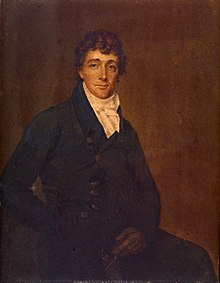
Key
Discussions friendly, the British at first don't wish to release the doctor, but relent after Key shows the officers a number of letters written by wounded British prisoners documenting the kind treatment they had received from Beanes. There is a problem however, during their stay aboard the HMS Tonnant, Key and Skinner have seen and overheard the British plans for attacking the city of Baltimore ... both men will be kept aboard the ship until the battle is over, as will Beanes.
Rocket Attack
And so it is that Key spends much of his evening watching nineteen British ships pound Fort McHenry (in the form of a five-sided star, surrounded by a dry moat ), and its 1,000 soldiers, under the command of 35-year-old Major George Armistead, with Congreve rockets and mortar shells (the bombardment, which started the day before, will last for over 25 hours ... during which over 2,000 shots will be sent the fort's way ... amazingly, only four men will be killed during the pounding, including African-American soldier Private William Williams, and a woman is cut in half by a shell bringing supplies into the fort ... there are also 24 soldiers wounded) ... transfixed by the American flag being lite up by all the explosions (angels watching, a British shell penetrates the fort's ammunition dump ... BUT FAILS TO GO OFF!). Finally going to his cabin for as much sleep as he can find amidst all the booming, he fully is expecting to find Fort McHenry occupied by British troops in the morning. Awakening and going out on deck, Key instead finds the flag still flying over the fort (unconquered and commanding the approaches to the harbor, the attack and occupation of Baltimore is called off and the British fleet heads south for a clash with Andrew Jackson in New Orleans) and is inspired to write a poem called "The Defence of Fort M'Henry" (a the back of a letter he is carrying in his coat pocket) ... words that will eventually became the national anthem of the United States of America.

McHenry Under Attack
Our Flag Was Still There By Dan Troiani

Fort McHenry - Present Day

Fort McHenry Statue Of Major Armistead
What Key doesn't know though is that the flag he saw the night before (called the Storm Flag, it is 17 feet by 25 feet large), has been replaced with a different flag (called the Great Garrison Flag), a larger flag, that is used every morning for reveille, a flag as Armistead states, "... so large that the British would have no difficulty seeing it from a distance." Indeed! Under a 1813 government commission, at a cost of $405.90, the flag is sewn by local 38-year-old seamstress named Mary Young Pickersgill (widowed at the age of 29), with assists from her daughter, Caroline, two nieces, Eliza Young and Margaret Young, elderly mother, Rebecca Young (a noted flag maker during the American Revolution) and a free African-American apprentice, Grace Wisher. A combination of cotton and dyed English wool bunting, when done, the flag measures 30 feet by 42 feet and consists of 15 stars (each about 2 feet in diameter) and 15 stripes (Vermont and Kentucky have become recent states) ... over 400 yards of fabric are used for the flag's creation, it takes the women six weeks to complete the banner. Kept by Major Armistead after the battle, the flag will remain in his family's possession until 1907, when it is loaned to the Smithsonian Institute for an exhibition ... in 1912, the family gives the flag to the nation as a gift, today, it is one display at the National Museum of American History, where it resides in a two-story, climate controlled viewing case.
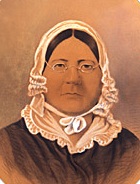
Pickersgill
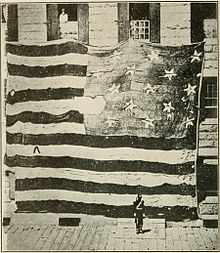
1873 Photo At The Boston Navy Yard
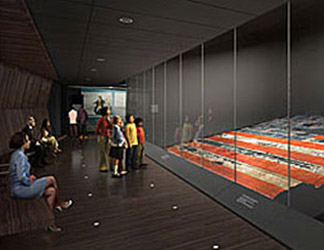
On Display
Finally off the British warship on 9/16, Key checks into Baltimore's Indian Queen Hotel and completes his poem. Done, the poem is then given to Key's brother-in-law, Judge Joseph H. Nicholson, who notices the words seem to fit to a popular tune of the time called "The Anacreontic Song" (the official song of the Anacreontic Society of London, a 18th Century British gentleman's club of amateur musicians) by English composer, John Stafford Smith. Words and music linked, Nicholson gets a local printer to make the first copies of the poem on 9/17/1814 (two copies still exist). On 9/20/1814, the song is published by the Baltimore Patriot and The American, shortly thereafter, seventeen more newspapers, from Georgia to New Hampshire, publish the words ... its first public performance as a song takes place the next month, when Baltimore actor Ferdinand Durang croons the tune at Captain McCauley's Tavern.
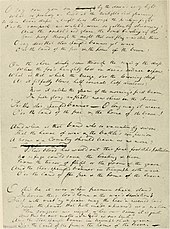
The Key Original
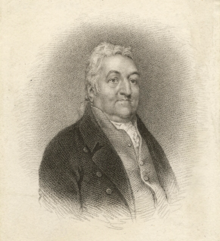
Smith

One Of The Two Copies Of The First Print
Growing more and more popular over the years as the tune becomes routinely heard at patriotic and sporting events around the country, in 1916, President Woodrow Wilson tasks five premiere musicians, Walter Damrosch, Will Earhart, Arnold J, Gantvoort, Oscar Sonneck, and John Philip Sousa with coming up with a single, standardized version of the song ... that version, the modern day one that has become the national anthem of the United States, debuts at Carnegie Hall on 12/5/1917.
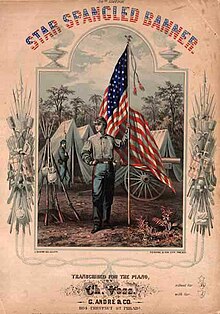
Sheet Music - 1862
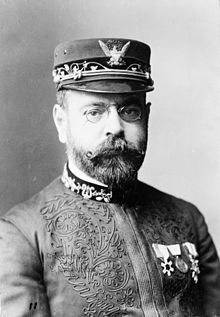

Sousa & Damrosch
On its march to becoming the country's anthem, on 7/27/1889, Secretary of the Navy, Benjamin F. Tracy, signs General Order #374, making it the official tune of the Navy for every time a ship raises its flag. In 1916, President Wilson (a big fan apparently), signs an executive order mandating the tune be played at military events. No official anthem for the country as the United States begins WWI, on 4/10/1918, Maryland Congressman John Charles Linthicum introduces a bill to make the song, by this time called "The Star Spangled Banner" into America's national anthem ... the bill does not pass, and Linthicum will introduce his bill five more times, his last on 4/15/1929. At roughly the same time, cartoonist Robert Ripley publishes a "Believe It Or Not" panel that shocks most of the country ... the United States is lacking an official anthem. Reminded of the deficiency, in 1930, the Veterans of Foreign Wars start a petition to Congress to have the song become the national anthem ... and over 5 million people sign the document before it is presented to Congress on 1/31/1930. On the same day as the petition is presented, the song is sung by Elsie Jorss-Reilley and Grace Evelyn Boudlin to the United States House Committee on the Judiciary to refute the notion that the tune is too high-pitched for the typical crooner. Enjoying what they heard, the committee votes in favor of releasing the bill for a positive vote, which takes place later that same year; joining in, the Senate passes the bill on 3/3/1931. On 3/4/1931, President Herbert Hoover signs the bill into law, and the United States of America has an official national anthem.

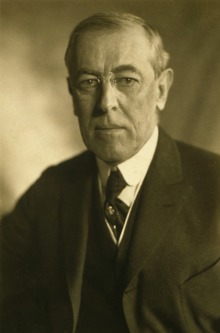
Tracy & Wilson

Linthicum
Ripley's Panel
While the anthem's first playing at baseball games can be dated back to 1897, its sports hook actually starts during the World Series of 1918 between the Chicago Cubs and the Boston Red Sox. Played in September due to a shortened season because of WWI, with a bomb blowing up only days earlier at the Chicago Federal Building (compliments of the Industrial Workers of the World union), the first game in Chicago draws only 19,000 to red, white, and blue bunting decorated Comisky Park, which is being used for the stadium's higher capacity, 30,000, rather than the Cubs regular home field at Weeghman Park. Being bested 1-0 by the Boston pitcher, a young lad by the name of Babe Ruth, desperate to get the quiet crowd engaged, which in turn is hoped will fire up the Cubs, in the bottom of the 7th inning the Chicago ownership has a small military band play "The Star Spangled Banner." At the first notes sounded, Red Sox third baseman, Fred Thomas, a former member of the Navy, snaps to attention and salutes the flag, prompting the other players to do the same ... and the quiet crowd goes nuts singing and cheering (though the game ends in a 1-0 loss), so much so that the moment is noted in newspaper reports, and the Cubs' owners decide to do it again for game two the next day ... and the second time the response to the song is even bigger (helped on by the day going to the Cubs, 3-1). Noting what has happened and not to be outdone, when the Series returns to Boston, the Red Sox decide to start the game with the song being played by a full brass band as wounded veterans that had been given free tickets to the game are honored on the field. And thus is a sporting tradition born of playing the anthem before games (it isn't until WWII begins that all of baseball adopts the routine ... oh, and if curious, the Red Sox take the title, 4 games to 2).

Press Pass
Pitcher Babe Ruth
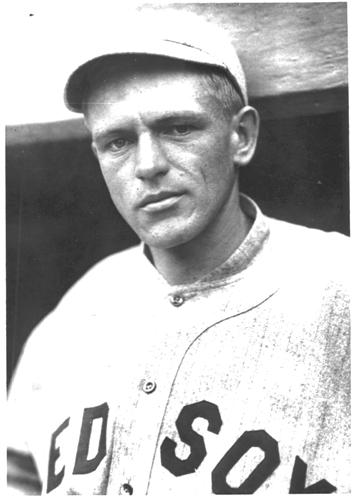
Third Baseman Fred Thomas
Oh, and just one last bit of trivia about the anthem. The day after the 9/11 attacks on the United States, in a gesture of solidity with America, the Queen of England breaks tradition and allows the Band of the Coldstream Guards to perform "The Star Spangled Banner" at Buckingham Palace during the ceremonial changing of the guards. And the next day, at a memorial service at St. Paul's Cathedral, in an unprecedented occurrence, the Queen of England joins in the song's singing!

Queen Elizabeth II - 2015
Why today mattered? It matter because of the words wrote on 9/14/1814, over 200 hundred years ago today. These words:
O! say can you see, by the dawn's early light,
What so proudly we hailed at the twilight's last gleaming,
Whose broad stripes and bright stars through the perilous fight,
O'er the ramparts we watched, were so gallantly streaming?
And the rockets' red glare, the bombs bursting in air,
Gave proof through the night that our flag was still there;
O! say does that star-spangled banner yet wave
O'er the land of the free and the home of the brave?
On the shore dimly seen through the mists of the deep,
Where the foe's haughty host in dread silence reposes,
What is that which the breeze, o'er the towering steep,
As it fitfully blows, half conceals, half discloses?
Now it catches the gleam of the morning's first beam,
In full glory reflected now shines in the stream:
'Tis the star-spangled banner, O! long may it wave
O'er the land of the free and the home of the brave.
And where is that band who so vauntingly swore
That the havoc of war and the battle's confusion,
A home and a country, should leave us no more?
Their blood has washed out their foul footsteps' pollution.
No refuge could save the hireling and slave
From the terror of flight, or the gloom of the grave:
And the star-spangled banner in triumph doth wave,
O'er the land of the free and the home of the brave.
O! thus be it ever, when freemen shall stand
Between their loved homes and the war's desolation.
Blest with vict'ry and peace, may the Heav'n rescued land
Praise the Power that hath made and preserved us a nation!
Then conquer we must, when our cause it is just,
And this be our motto: 'In God is our trust.'
And the star-spangled banner in triumph shall wave
Whose broad stripes and bright stars through the perilous fight,
O'er the ramparts we watched, were so gallantly streaming?
And the rockets' red glare, the bombs bursting in air,
Gave proof through the night that our flag was still there;
O! say does that star-spangled banner yet wave
O'er the land of the free and the home of the brave?
On the shore dimly seen through the mists of the deep,
Where the foe's haughty host in dread silence reposes,
What is that which the breeze, o'er the towering steep,
As it fitfully blows, half conceals, half discloses?
Now it catches the gleam of the morning's first beam,
In full glory reflected now shines in the stream:
'Tis the star-spangled banner, O! long may it wave
O'er the land of the free and the home of the brave.
And where is that band who so vauntingly swore
That the havoc of war and the battle's confusion,
A home and a country, should leave us no more?
Their blood has washed out their foul footsteps' pollution.
No refuge could save the hireling and slave
From the terror of flight, or the gloom of the grave:
And the star-spangled banner in triumph doth wave,
O'er the land of the free and the home of the brave.
O! thus be it ever, when freemen shall stand
Between their loved homes and the war's desolation.
Blest with vict'ry and peace, may the Heav'n rescued land
Praise the Power that hath made and preserved us a nation!
Then conquer we must, when our cause it is just,
And this be our motto: 'In God is our trust.'
And the star-spangled banner in triumph shall wave
O'er the land of the free and the home of the brave!
And a stanza written by an indignant Oliver Wendell Holmes, Sr.
(the father of the future Supreme Court justice) at the beginning
of the Civil War in 1861:
When our land is illumined with Liberty's smile,
If a foe from within strike a blow at her glory,
Down, down with the traitor that dares to defile
The flag of her stars and the page of her story!
By the millions unchained who our birthright have gained,
We will keep her bright blazon forever unstained!
And the Star-Spangled Banner in triumph shall wave
If a foe from within strike a blow at her glory,
Down, down with the traitor that dares to defile
The flag of her stars and the page of her story!
By the millions unchained who our birthright have gained,
We will keep her bright blazon forever unstained!
And the Star-Spangled Banner in triumph shall wave
While the land of the free is the home of the brave.
Amen!!!!!!!!!!!!!!!!!!!!!!!!!!
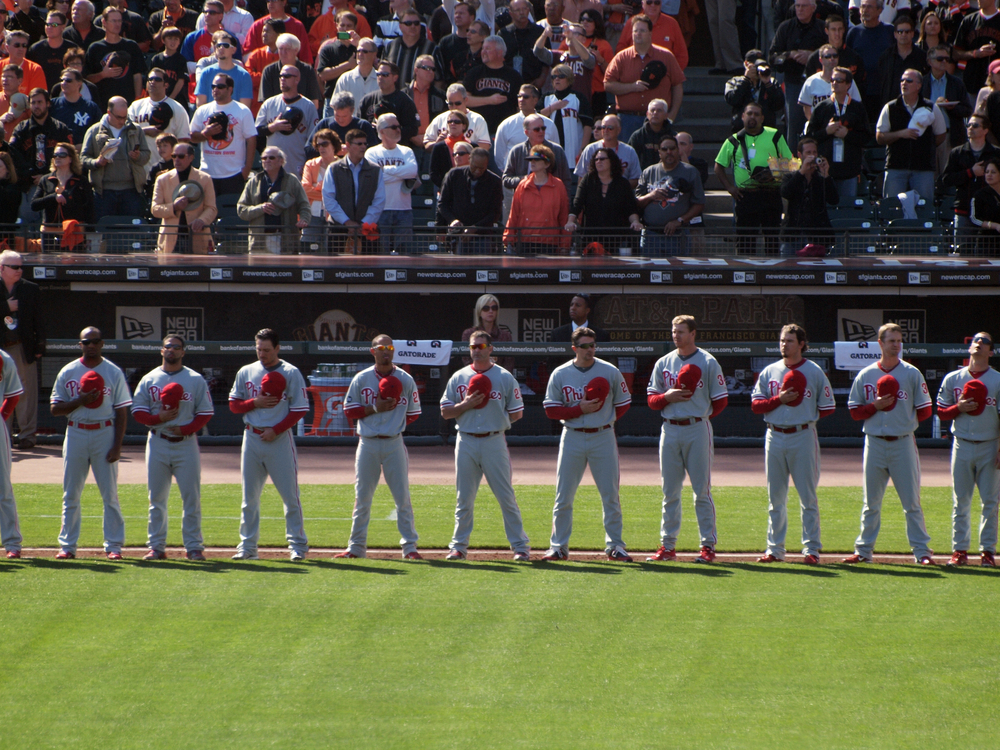
No comments:
Post a Comment